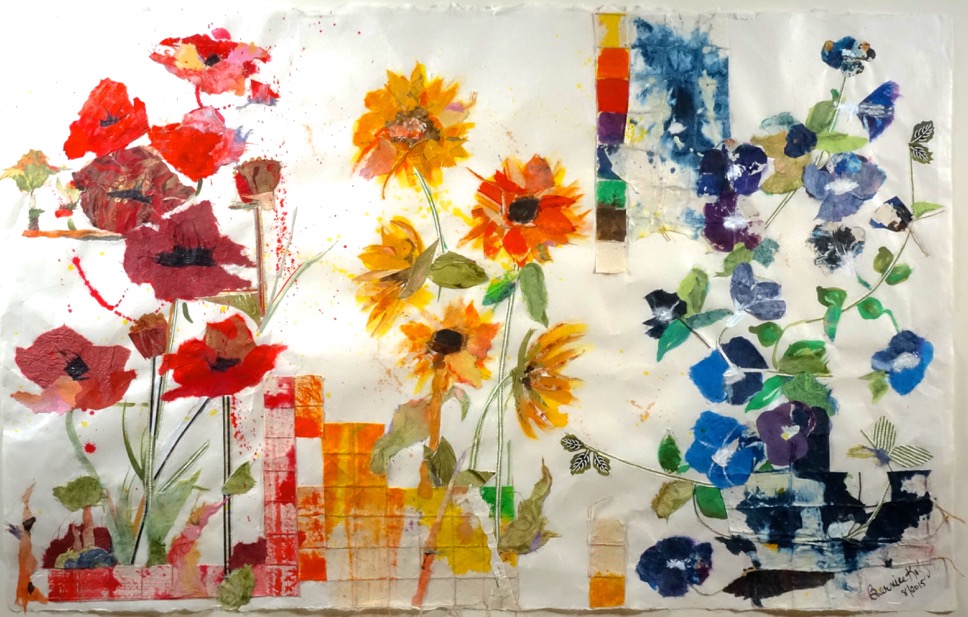Floral Triptych I MM on Paper My art life and previous life are coming together…

“Enameling is a dying art”. I refused to believe it! I just came back from Austria, where I expected to see and maybe buy some pieces of the most beautiful enamel work, as I remember they had many years ago. I was greatly disappointed when I could not find one piece of traditional or modern enamel anywhere in Vienna or Salzburg. I asked everywhere and nobody knew where to find it. I finally found a jeweler who told me of a small shop on the outskirts of Vienna that might have a few pieces. I never found it. The irony is that most of the enamels that I use on my work are Schauer enamels from Austria. Well, I’ll treasure the few pieces I have from Austria, France, Germany, Chile and Mexico. Maybe they still make it? But if you want to see beautiful enamel work on this country you should go to the Enamelists Gallery at the Torpedo Factory in Old Town Alexandria, Virginia. I was a member of that gallery for 10 years. I stop working on enamels in 1994 when we moved to Chapel Hill. Since then I have been working on children books, botanical illustration, and many other things, but now after 16 years I’m back doing enamels, experimenting with techniques and working on mix media. It’s exiting.
What is Enamel?
The word “enamel” refers to the glass material as well as to the finish product. Enameling is the process of applying a specially prepared glass to metal and then fusing the two together through the use of heat.
More than any other medium utilizing color, enamel is permanent. The color will not fade over time due to light, and the texture will not change or decay. Only a hard blow or fall can destroy or damage the enamel. In addition to these qualities, its gemlike surface, brilliance and richness of color and the light shining through the enamel and reflecting the metal underneath it showing depth, all contribute to the luxurious appearance of enamel work.
Enamels can be bond to most metals, like gold, silver, copper, steel, cast iron, aluminum and titanium. The enamel becomes a veil of color between the metal and all else.
History
Enameling is an art form with a long and rich heritage. The Greeks were enameling gold jewelry as early as the 5th Century B.C., as did the Celtics in the 1st Century BBC and during the Byzantine era. In the 4th through 12th Centuries, numerous enamel religious works were produced. The artisans in Limoges perfected the use of enamels in a painting technique in the 15th Century. The 17th, 18th, and 19th Centuries and the early decades of the 20th, saw production of a great volume of luxury and decorative enamels. Cloisonné was also employed by the japanese and chinese since the last part of the 19th century. The use of enamels for utilitarian purposes started at the end of the 19th Century. First on pots and pans for cooking, then stoves, refrigerators, kitchen sinks, bath tubs, laundry appliances, architectural panels, etc…
Enameling materials
Contemporary enamelists can purchase enamels in many forms. Powdered enamels can be transparent, opaque, opalescent or clear, called flux. Also painting enamels, watercolor and acrylic enamels, under glaze pencils, chalks, ceramic pigments, lumps, chips, and threads and decal papers.
Lead-free enamels are safer to use and more acid resistant. All enamels, both lead-free and lead-bearing contain ingredients that can be hazardous when inhaled. When sifting any type of enamel, always wear a mask and fire enamels in a well-ventilated area. Here is a picture of me at my kiln which is 9”x9” inside.

How is it done?
The enamel (glass) is crushed to a powder finer than granulated sugar and coarser than flour. This powder is applied, by one of several methods, to the metal surface and heated in a kiln at a temperature of between 1000º to 1600º F or with a hand held torch. After a few minutes the piece is removed and allowed to cool at room temperature. Several coats are applied and sometimes one piece will require 10 or more firings to bring about the desire results.
Covering both sides of the metal with enamel evenly distributes the stress of expansion and contraction.The coat on the front of the piece is called the base coat, and the coat on the back is the counter enamel. It will warp less if the counter enamel is about as thick as the base coat.
Techniques
The traditional techniques include: Limoges, cloisonné, basse-taille, champlevé, grissaille, plique-a-jour and repoussé. In addition to those you can use sgraffito, stenciling, silver and gold foils and liquids, or combinations. In modern enamels you will find a variety and combination of techniques such as highfiring, copper collage, fusing glass chunks and threads, burnout, oxidation, electroplating or firescale. Any possible combination that produces the results that you are looking for is worth experimenting.
Following is a brief description of the traditional techniques. You can find much more information on the Internet.
Limoges
In the Limoges or wet inlay technique, moistened enamels are applied onto a metal surface, in a thin and uniform coat using special inlay tools or a brush.
Basse-Taille
In basse-taille, a french word meaning “low cut”, the metal surface is treated extensively through a variety of techniques like etching, engraving, hammering, stamping, carving, punching or scratching. Several layers of transparent enamels are then fired over this base.
Cloisonné
Cloisonné is from the french word cloisons, meaning “partitioned areas” or cells. In this technique the enamels are separated from each other by thin metal wires.This metal dividers form the design. The wires are fixed upright to the surface to form the cells which are then carefully filled with enamel until the color reaches the level of the wires.
Champlevé
In champlevé or “raised plane” areas of the metal are etched with acid to form recessed compartments. Enamels are then wet inlaid in the recessed areas until they are flushed with the surrounding metal.
Grisaille
The word is from the french gris, meaning “gray”. Grissaile resembles Limoges in terms of technique, but no color is utilized. A finely ground white opaque is applied to a fired black opaque base, and designed details are scratched through or are painted on with liquid enamel. The design is established by building up successive coats of white that fused into the black base to form a gray/white image.
Plique-a-jour
The beauty of this technique is reveal in its transparency. This technique uses transparent enamels without metal backing, looking like a miniature stain window. There are four methods to create plique-a-jour:
- Pierced Plique-a-jour
- Cloisonné wiring and acid etching
- Cloisonné wires on mica
- Soldered filigree
Repoussé
In repoussé the metal is formed from the back to produce areas of high and low relief that can become highly complex, to the point of becoming and sculpture. The metal is worked with different hammers. The process of delineation is called chasing. Extremely beautiful copper pieces can be achieved with this technique.
Here is a sample of my work, which is completely non-traditional. I have made a piece and taken pictures at various stages to show some of the process. Below the pictures is a description of the process.
The completed work is seen at the top of this article.

This piece has at least six or seven firings. Here are the steps:
- I started with two 6”x6” enameled steel plates with a white cover coat and counter enamel on the back, which I had previously enameled but that I did not like. That’s the beauty of working non-traditional, you can recycle.
- Over those colors I sifted my design, free hand. The colors are opaque but they will sink on the kiln and pick up some of the colors underneath. I fired them one by one at 1400ºF. (See the first picture of the process above)
- In the next step I created shapes with silver foil and I also formed round copper wires to create a loose cloisonné. I applied transparent flux and colors over all the silver, more of the background color for a heavier coat and wet enamels inside the wires. (See the second picture of the process above) and after firing (See the third picture of the process above)
- The next step was to add more color on the trees and the houses and glass lumps and threads for texture.
- After I fired that I wanted to have more color at the bottom so I sifted some light green over the purple and placed some millefiore beads and glass threads. I also carefully applied, with a limoges technique, light blue enamel around the water creatures to create more contrast and detail and some specks of glass and on the house shapes.
- The following step was to apply the liquid gold with a fine pen over the black background and on the water creatures. The gold needs to be carefully monitored because low firing won’t turn to gold and very hot can burned it. This last firing enables the enamels to sink a little bit more onto the previous colors and blend together. I like that look and the accidents that can happen.
- In between every firing I have to clean the oxide from the copper wires. You don’t want specks flying over your colors and also it makes it easier to clean after the piece is done.
- The last thing is to carefully clean the wire with a copper cleaner and the finest wet sanding paper. I finally burnish the copper for a clean look.
This is just “scratching the surface”. Enameling is a complex and demanding process that can deliver beautiful results. I hope you will have a better appreciation for this ancient and beautiful technique.
Visit Miriam’s website to see her work. See the work of all OCAG artists
Comments (2)
Leave a Reply
You must be logged in to post a comment.


Well explained process of enameling helps me to appreciate this form of art even more so…Thank you Miriam!
I seldom leave comments on blog, but I have been to this post which was recommended by my friend, lots of valuable details, thanks again.